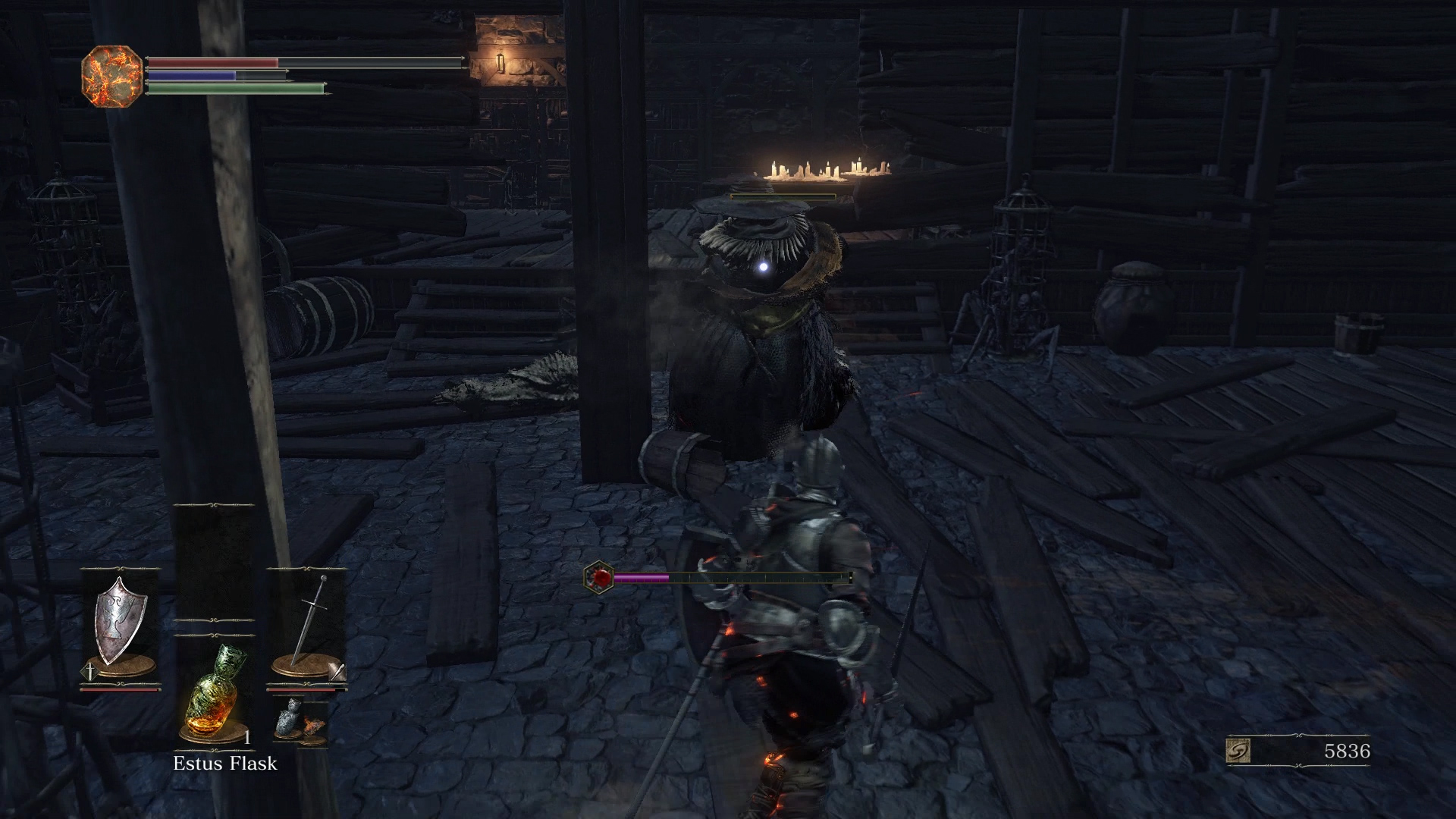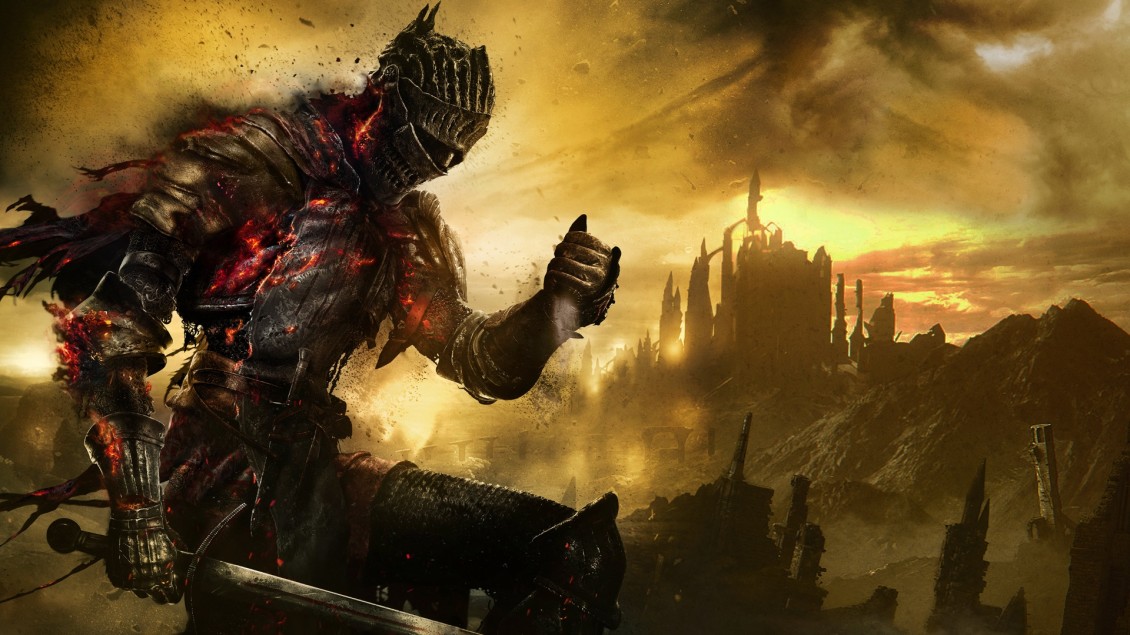April 12, 2016.
The latest Souls adventure actually takes a little while to click. For a while it feels as though you’re playing a FromSoft game; a Souls game, and it’s all fine and good, almost like putting on a pair of comfortable shoes. The first boss transforms from a generic Knight into a monstrosity of swarming, flailing limbs, and its attacks change with its appearance. But we’ve seen bosses that have second phases, and we’ve seen enemies that transform thanks to the genuine brilliance of Bloodborne.
Specifically, it was when I felled the first Lord of Cinder I came across what makes it feel special. Having traipsed through screeching monkey-like enemies that I could kill quickly if I got the jump on them (before they sprout wings and leap at me, giving no respite to regain my senses and mount my attack) and all manner of swamp dwelling evils, I felt as though I was approaching a lord’s quarters. A cut-scene played out, and the battle started. My first try was pathetic, but that’s fine: a large part of From’s set pieces is about learning attack patterns and understanding how they’ll play out. But this was different, somehow. Amid a pile of reanimating corpses, my enemy would be attacked by his own duplicates, and I could use it to my advantage. And so I won… until, that is, the second phase started and he took me down amid a flurry of fire and speed. I bested him eventually, five tries later, and the elation was met only by my admiration for the set piece. I could feel my heart pounding, and my palms were sweaty – it’s a genius encounter that feels so utterly special, so completely Souls.
If anything, Dark Souls 3 feels like a greatest hits collection. Characters and locations from the entire catalog are here, whether it’s directly or in homage (even Demon’s Souls gets a nod). But let’s get this out of the way right now: this is not Bloodborne 2. Yes, Dark Souls 3 is faster than the rest of the series, and yes there are often visual similarities in some areas, but this is completely Dark Souls. But there are concessions, and weapon arts feel like a nod to the PS4-exclusive. A new third bar is yours to drain, and it’s basically a magic/mana bar. Every weapon or shield you find has a weapon art, and one of those is familiar: parry. Shields parry, obviously, but some shields have a weapon art that defers to your right hand. Otherwise, if you’re carrying a sword, to use that weapon art you will need to grasp it with two hands.
I preferred “stance”, which is exactly as it sounds: you draw your sword back in a prepared stance, and unleash an attack with the standard or heavy attack. Bows can quickly fire, or fire as you finish a roll, or hit harder with a precise, powerful drawn strike. Wands, chimes, and Talismans can buff, and experimenting with a combination of all manner of these arts, along with your class will find you with your favourite. After starting as a Thief, it became clear that class was not for me. Sacrificing strength for speed isn’t my idea of a good time, so playing as a Knight leaning towards strength, with enough skill to use a healing spell and soul arrow if I needed it was the order of the day. But the FP bar (focus points, officially) begins to feel underused as you approach the second half of the adventure, and seems aimed more at magic users than the sword and shield type I prefer. After a while I was barely using it (only for the extra heal if I was deep into an area with no bonfire in sight), and many times I considered swapping to entirely health based estus flasks.
Difficulty is always a discussion when it comes to these games, of course, but the first half of the game feels like the easiest Souls game yet. While some bosses will kill you first time, and over-confidence will mean a simple mob can end you, I have to say I found it generally easier than usual. There’s a huge variety of enemy types, beautifully typified in the Undead Settlement. Present there are small enemies that you can kill quickly, but that will absolutely wreck you if they get that first hit in. Elsewhere, grunt enemies that wouldn’t look out of place in Bloodborne or Resident Evil 4 are mixed in with hulking beasts that sprint at you with a handsaw, wildly pummeling wherever you are, or used to be. Skeletons, frogs, bone-dogs, rats; christ, even giant enemy crabs (seriously) patrol the environment, and every single one has the potential to kill you.
Bosses become the challenge in the late game, and there are two or three that nearly made me quit. The trouble is that the pattern recognition and learning seemed to give way to luck. While normally you don’t feel cheated by the series, I found that the few that took 20-odd tries were eventually bested by luck, rather than skill. At the end, when I’d finally beaten the ones who gave me trouble, I didn’t feel as though I was doing anything different to the first attempt. Moreover, the later bosses have a tendency to use one-hit-kills too often. Some of them, well, if you’re not at full health and you get caught in it: you’re dead – some will even kill you in one if you are at full health.

NPCs litter the early game, each with their own quest that will see them enter your service back at Firelink Shrine, your hub for leveling up, infusing weapons, and chatting to your new-found kin. It might not be a popular decision to stick with the hub idea, but it works here better than ever. It becomes a home for your avatar, somewhere safe to learn about the world you’re inhabiting. It slowly grows along with you, despite the ever-present fact that you are in a shrine to the people you are going to kill, before placing their ashes onto their final resting place: the very chair they are supposed to rule from.
The areas you visit are fairly regular souls-like places, with some exceptions I won’t ruin here. A castle, a mausoleum, a forest, a swamp – you name it, as I said: this is a greatest hits of souls. But there are some breathtaking vistas that surprise you when you least expect them to. But there’s more to Dark Souls 3 being a new game than weapon arts and a three. Ember is a new consumable that makes your health bar bigger until you die, but it also enables online play. Hollowing has been removed in that it doesn’t affect your health bar, but it does exist in some fashion. Once it’s enabled (I won’t spoil how) you can buy a consumable to remove it, and you can buy a ring that removes the visual effect of “hollowing”, but at no point was I punished by a lower health bar due to death, instead it’s something that affects covenants and which ending you get.
Combat remains untouchable in its excellence, though. The thrill of timing your attacks, or indeed your defensive parry or roll, remains unparalleled. In fact the only misstep is the same old From Software technical problems, that, on PS4 (and Xbox One), reared up in the form of horrendous slowdown and frame drops in a few areas. Look, I adore this game and the series From has created, but I’m not an apologist, either, and some of the framerate drops in these areas are unacceptably bad. I truly hope a patch addresses it, because for all the architectural brilliance, and how pretty some areas look in their decaying beauty, From really cannot make their engine handle fire, or extremes of light. Your mileage may vary, but I found it a persistent issues throughout my 30 hours playing it.
But it is pretty in its darkness. While the green swampy areas look bland and almost ugly in places, the castles and world design yet again show the team understand scale and structure like few others do. After beating the second boss you walk out into the open and see the future: where you’ll visit, where you’ll die, over and over. The locations are typical, sure, but they are interlinked in such a clever way, and that may be Miyazaki’s true genius. Returning to an area that’s somehow anew because of how you discovered it, or visiting locations that resemble others: that never gets old.
It sounds great, too. The Souls games are always loud affairs, and the moments of exploration are punctuated violently with sudden screams from lunging enemies. Skeletons will collect their bones back to together and pick themselves up to fight, and it sounds like they’re doing just that. Sweeping orchestral scores accompany boss fights adding so much tension, with that sonic propulsion making you feel like you’re never safe. The voice acting is decent as well, with believable characters. Subtle when it needs to be, and bombastic and explosive otherwise, the audio is an unsung hero of From’s design, and it’s never more apparent than it is here.
Perhaps most importantly, Dark Souls 3 corrects errors made in Dark Souls 2. I enjoyed that second game, but I felt like the boss battles were very by the numbers; especially early on. Here, they are epic occasions and unforgettable moments. Transformations are used cleverly, changing locations and switching things up. I remember every one of my boss encounters, even the ones I found a little too easy, because From has nailed the spectacle so completely. While there are a few fights that feel unfair rather than challenging, with the decks stacked against you, and although it doesn’t quite match up to Bloodborne, Dark Souls 3 is still a spectacular game.
Support us by buying from one of these links:
Incredible world building.
Combat is still the best.
Rewarding like few other games.
The best co-op implementation so far.
Frame-rate issues are persistent on console.
Some bosses feel unfair.
Way too many mimic-chests.
Invasion latency is currently poor.
Dark Souls 3 is yet another example of how worlds should be built: interlocking, beautiful, and interesting. The combat feels quick and fresh, and despite a few bosses that feel unfair, it's a glorious return to form for the series.


